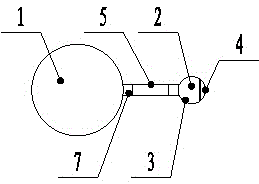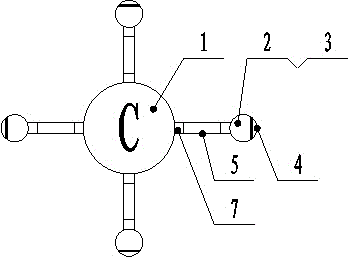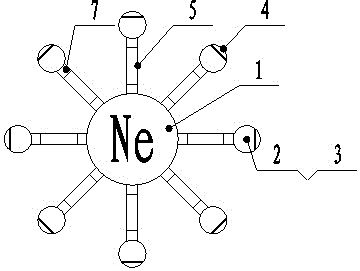Chemical model
A model and chemical technology, applied in the field of chemical models of atoms or molecules, which can solve problems such as the inability to intuitively understand the formation process of covalent bonds, and the lack of molecular models to reflect the number of nuclei and outermost electrons.
- Summary
- Abstract
- Description
- Claims
- Application Information
AI Technical Summary
Problems solved by technology
Method used
Image
Examples
Embodiment 1
[0031] Example 1: Combination figure 1 , A chemical model, including a central sphere 1 and an extended sphere 2. The extended sphere 2 is composed of a large hemisphere 3 and a small hemisphere 4. The circular planes of the large hemisphere 3 and the small hemisphere 4 are each provided with a layer of magnetic material , The central sphere 1 and the large hemisphere 3 are connected by an elastic connecting rod 5, both ends of the elastic connecting rod 5 are provided with a connector 7 which is threadedly connected with the large hemisphere 3, and the connecting head 7 is threadedly connected with the central sphere 1. This model can be used to represent the hydrogen atom, lithium atom, sodium atom and other atoms and their outermost electrons.
Embodiment 2
[0032] Embodiment 2: Combination figure 2 , A chemical model, including a central sphere 1 and four extended spheres 2, each extended sphere 2 is composed of a large hemisphere 3 and a small hemisphere 4, the large hemisphere 3 and the small hemisphere 4 are set on the circular plane There is a layer of magnetic material. The center sphere 1 and the large hemisphere 3 are both connected by an elastic connecting rod 5. Both ends of the elastic connecting rod 5 are provided with a connector 7 which is an interference fit with the large hemisphere 3, and the connector 7 is connected to the center. Sphere 1 has an interference fit. In the figure, the central sphere with the letter C represents the carbon nucleus, and this model represents the model of the carbon atom and its outermost electron.
Embodiment 3
[0033] Embodiment 3: Combination image 3 , A chemical model, including a central sphere 1 and eight extended spheres 2, each extended sphere 2 is composed of a large hemisphere 3 and a small hemisphere 4, the large hemisphere 3 and the small hemisphere 4 are set on the circular plane There is a layer of magnetic material. The center sphere 1 and the large hemisphere 3 are both connected by an elastic connecting rod 5. Both ends of the elastic connecting rod 5 are provided with a connector 7 which is an interference fit with the large hemisphere 3, and the connector 7 is connected to the center. Sphere 1 has an interference fit. In the figure, the central sphere with the letter Ne represents the neon nucleus, and this model represents the model of the neon atom and its outermost electrons.
PUM
 Login to View More
Login to View More Abstract
Description
Claims
Application Information
 Login to View More
Login to View More - R&D
- Intellectual Property
- Life Sciences
- Materials
- Tech Scout
- Unparalleled Data Quality
- Higher Quality Content
- 60% Fewer Hallucinations
Browse by: Latest US Patents, China's latest patents, Technical Efficacy Thesaurus, Application Domain, Technology Topic, Popular Technical Reports.
© 2025 PatSnap. All rights reserved.Legal|Privacy policy|Modern Slavery Act Transparency Statement|Sitemap|About US| Contact US: help@patsnap.com



